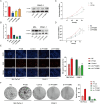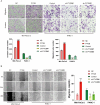Unveiling the role of PYGB in pancreatic cancer: a novel diagnostic biomarker and gene therapy target
- PMID: 38483604
- PMCID: PMC10940407
- DOI: 10.1007/s00432-024-05644-2
Unveiling the role of PYGB in pancreatic cancer: a novel diagnostic biomarker and gene therapy target
Abstract
Purpose: Pancreatic cancer (PC) is a highly malignant tumor that poses a severe threat to human health. Brain glycogen phosphorylase (PYGB) breaks down glycogen and provides an energy source for tumor cells. Although PYGB has been reported in several tumors, its role in PC remains unclear.
Methods: We constructed a risk diagnostic model of PC-related genes by WGCNA and LASSO regression and found PYGB, an essential gene in PC. Then, we explored the pro-carcinogenic role of PYGB in PC by in vivo and in vitro experiments.
Results: We found that PYGB, SCL2A1, and SLC16A3 had a significant effect on the diagnosis and prognosis of PC, but PYGB had the most significant effect on the prognosis. Pan-cancer analysis showed that PYGB was highly expressed in most of the tumors but had the highest correlation with PC. In TCGA and GEO databases, we found that PYGB was highly expressed in PC tissues and correlated with PC's prognostic and pathological features. Through in vivo and in vitro experiments, we found that high expression of PYGB promoted the proliferation, invasion, and metastasis of PC cells. Through enrichment analysis, we found that PYGB is associated with several key cell biological processes and signaling pathways. In experiments, we validated that the MAPK/ERK pathway is involved in the pro-tumorigenic mechanism of PYGB in PC.
Conclusion: Our results suggest that PYGB promotes PC cell proliferation, invasion, and metastasis, leading to poor patient prognosis. PYGB gene may be a novel diagnostic biomarker and gene therapy target for PC.
Keywords: Bioinformatics analysis; Brain glycogen phosphorylase (PYGB); MAPK/ERK; Metastasis; Pancreatic cancer; Proliferation.
© 2024. The Author(s).
Conflict of interest statement
The authors declare that the research was conducted in the absence of any commercial or fnancial relationships that could be construed as a potential conflict of interest.
Figures












Similar articles
-
PYGB siRNA inhibits the cell proliferation of human osteosarcoma cell lines.Mol Med Rep. 2018 Jul;18(1):715-722. doi: 10.3892/mmr.2018.9022. Epub 2018 May 16. Mol Med Rep. 2018. PMID: 29845265 Free PMC article.
-
Silencing of PYGB suppresses growth and promotes the apoptosis of prostate cancer cells via the NF‑κB/Nrf2 signaling pathway.Mol Med Rep. 2018 Oct;18(4):3800-3808. doi: 10.3892/mmr.2018.9388. Epub 2018 Aug 14. Mol Med Rep. 2018. PMID: 30106110 Free PMC article.
-
Hypoxia Stimulates PYGB Enzymatic Activity to Promote Glycogen Metabolism and Cholangiocarcinoma Progression.Cancer Res. 2024 Nov 15;84(22):3803-3817. doi: 10.1158/0008-5472.CAN-24-0088. Cancer Res. 2024. PMID: 39163511
-
Glycogen Phosphorylase B Is Regulated by miR101-3p and Promotes Hepatocellular Carcinoma Tumorigenesis.Front Cell Dev Biol. 2020 Nov 25;8:566494. doi: 10.3389/fcell.2020.566494. eCollection 2020. Front Cell Dev Biol. 2020. PMID: 33324633 Free PMC article.
-
Investigating the regulatory role of miRNAs as silent conductors in the management of pathogenesis and therapeutic resistance of pancreatic cancer.Pathol Res Pract. 2023 Nov;251:154855. doi: 10.1016/j.prp.2023.154855. Epub 2023 Oct 5. Pathol Res Pract. 2023. PMID: 37806169 Review.
Cited by
-
Aberrant expression of PYGB as a potential therapeutic target and its associations with immune cell infiltration in lung cancer.Front Immunol. 2025 May 19;16:1536248. doi: 10.3389/fimmu.2025.1536248. eCollection 2025. Front Immunol. 2025. PMID: 40458414 Free PMC article.
References
-
- Barrett T, Wilhite SE, Ledoux P, Evangelista C, Kim IF, Tomashevsky M, Marshall KA, Phillippy KH, Sherman PM, Holko M, Yefanov A, Lee H, Zhang N, Robertson CL, Serova N, Davis S, Soboleva A (2013) NCBI GEO: archive for functional genomics data sets–update. Nucleic Acids Res 41(D1):D991–995. 10.1093/nar/gks1193 - PMC - PubMed
-
- Chrysina ED (2010) The prototype of glycogen phosphorylase. Mini Rev Med Chem 10(12):1093–1101. 10.2174/1389557511009011093 - PubMed
MeSH terms
Substances
Grants and funding
LinkOut - more resources
Full Text Sources
Medical
Molecular Biology Databases
Miscellaneous

